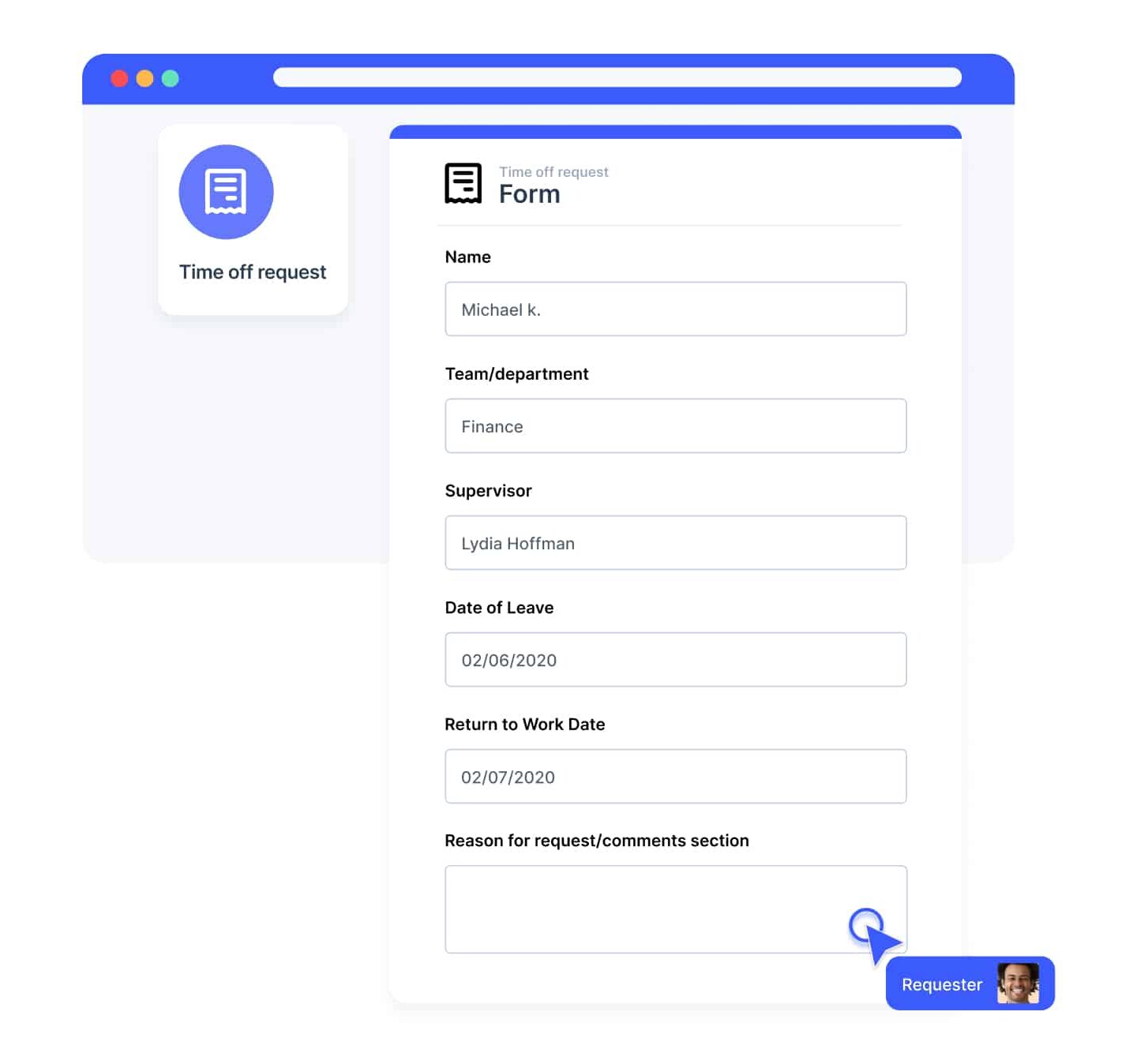ARTICLE SUMMARY
Standardization and automation can make the process more organized and efficient.

What is a leave or time off request?
Whether it’s due to an illness, a trip planned months in advance, or an emergency, leave requests are common in the workplace. Even so, handling them can be a challenge for managers, who have to take care of their employees while also minimizing the impact of absences on their teams and their business.
The good news is that there are some proven strategies for optimizing your lead management process to make it easier on your team (and yourself). In this article, we’ll explore the various types of leave and time-off requests, and offer some best practices to help you manage those requests with minimal disruption or frustration.
Common types of leave requests
| Paid time off (PTO) | Time where the employee is not working but continues to receive their salary or hourly wages. |
| Unpaid time off (UTO), or leave without pay (LWOP) | The employee does not work and does not receive their salary or hourly wages. |
| Vacation | A set number of days (or hours) set aside in advance and/or accrued during the employee’s tenure with the company. These days can be used at the employee’s discretion for a variety of personal reasons including but not limited to pre-planned travel. Some companies may use vacation time interchangeably with PTO. |
| Sick leave | Time taken due to personal illness. The employee may or may not receive pay during this time. |
| Maternity, paternity, or parental leave | Time away from work that can be taken directly after the birth or adoption of a child The amount of time granted is at the discretion of the employer, with guidance from The Family and Medical Leave Act of 1993. |
| Family and medical leave | Enforced by The Family and Medical Leave Act of 1993 (FMLA), allows employees “unpaid, job-protected leave” for various medical and family reasons, such as the birth of a child or recovery from a serious illness. |
| Bereavement leave | Can be requested upon the loss of a close relative. The length and availability of this type of leave is often at the discretion of the employer. |
| Leave of absence | If the requested time off does not fall into one of the preceding categories, it may be considered a leave of absence. During this time, an employee retains their employment status for a defined period of time, with or without pay. An LOA is commonly associated with exceptional circumstances. |
Why is effectively managing leave requests so important?
In general, a transparent leave request policy and organized approval process reduces the complexity of managing requests and minimizes friction within your company. But there are other benefits that come from improving your time off management processes.
Increases visibility into team capacity
Time off, especially unexpected time off, can disrupt team workflows and capacity. Smaller teams or businesses in a growth cycle can be disproportionately affected. For instance, a lean team with a high workload will be much more strained when unexpected leave occurs, as the remaining members of the team must adapt with already limited bandwidth.
An optimized process for managing time off requests can provide managers with additional visibility into a leave request’s impact on team capacity. As a result, managers can anticipate, plan for, and respond to this impact more quickly.
Defines expectations and builds trust
A standardized leave management process will ensure that employees have reasonable expectations and are not surprised by your response to their leave requests. This may increase a sense of fairness and trust among your employees, and thus prevent misunderstandings that can arise if a process is seen as inconsistent.
Creates efficiency
Leave requests can quickly become complex and require a lot of time and energy to manage. For example, a time off request may require input from multiple managers, HR, the employee, and the employee’s teammates or supervisor. This can be especially complicated if the primary tool of communication is email. A standardized or automated process can make the process more efficient and manageable.
Assists with compliance
Federal, state, and local laws will have an impact on your company’s leave policy. For example, these regulations may determine the amount of time an employee can take off, and for what reasons. Non-compliance can be costly for employers, and a well-defined process can help managers stay within legal and company policy guidelines.

3 tips for managing leave requests
Managing requests for time off is one of the most sensitive and important tasks a manager has to handle, and the number of factors affecting leave requests can make them complex and time-consuming. Here are some proven strategies for making the leave request process easier for your team, and your employees.
1. Go transparent
Creating a coherent and open policy is key to providing a sense of transparency to employees. This should help reduce concerns about fairness and minimize leave request rejections. In order to create a transparent policy, consider the following:
How much paid (and unpaid) leave can your employees take? Make sure to take into account state and federal laws as you craft your policy.
- How much advance notice is needed to request time off?
- Are blackout dates necessary? This is useful for businesses that have particularly heavy workloads in certain times of the year. For example, a retail business will unlikely be able to give much time around Black Friday. However, blackout dates shouldn’t be abused since they can frustrate employees who may have personal obligations.
- Are there other business-specific considerations that need to be factored in?
- Define the approval process.
- Have clear processes about overlapping requests, if applicable. Standard ways to prioritize requests are by importance, seniority, or a first-come-first-served basis.
2. Automate and standardize
Managing time off for your team can require a lot of time and effort. Managers may have to request, verify, and track relevant information from a number of sources, including the employee, the HR department, and other stakeholders. For example, this information may include the number of PTO hours an employee has accrued, how much time off the employee has used, and who is responsible for coverage during the absence.
Automation can reduce the time a manager spends managing time off requests by standardizing the process and resolving repetitive tasks (such as email). This lets managers spend more time on planning and decision-making, and less time handling minutiae or chasing down communications. An automated, standardized process can also make it easier to consolidate communications and relevant data into a single source, reducing the amount of time needed to locate and organize information.
3. Create a leave request form
A standardized time off request form can help employees understand their company’s time off policy and help managers make informed decisions quickly. When inputs are required, all of the relevant information must be included before the request can be processed. A structured time off request form also makes it easier to automate and organize a large volume of requests.
Example time-off request template
Some standard fields in a time off request form may include:
- Name
- Email or employee ID
- Department
- Date of leave
- Return-to-work date
- Reason for the request (e.g. vacation, maternity leave, etc.)
- Additional information
- Attachments
Time off requests can be customized for unique business needs, and modified as policies and processes change.

Build an effective, scalable leave management process
Transparency, consistency, and standardization are the keys to managing time off requests with efficiency. Automation can further minimize the work and complexities needed to help you take care of both your employees and your company.
Pipefy helps managers take control of their leave management process by eliminating redundancy, improving communications, and organizing information for increased visibility and better planning. Customizable templates and workflows help you build a process that works for you and your employees.
Pipefy helps managers take control of their leave management process by eliminating redundancy, improving communications, and organizing information for increased visibility and better planning. Customizable templates and workflows help you build a process that works for you and your employees.






